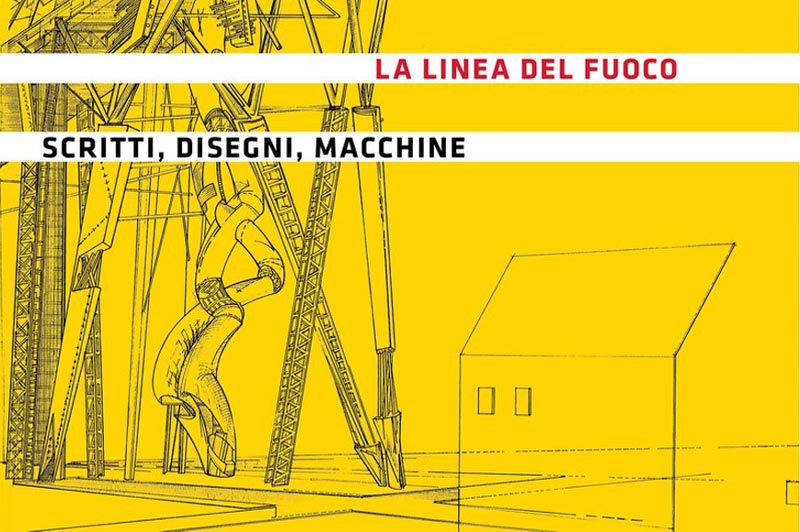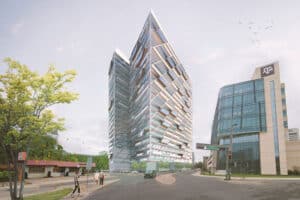Ancient How-To Books exist in every field—from Books of the Dead to books on how to live; yet perhaps no manual in history has gained the unique doctrinal and authoritative power over humanity as Vitruvius’ Ten Books of Architecture.
There they stand, all ten of them—and of course there would be exactly ten, that most perfect number of power—guiding mankind through twenty centuries of building; their authority stretching far beyond the Roman world, beyond even the West itself, into Islamic and Indian architecture, and through the European Renaissance into modernity, and through modernity into the contemporary globalized world. With their deference to the right angle and the right way of building, with their preoccupation with geometric order, symmetry and strict proportions, the Ten Books have become a kind of emblem for all that has become codified and institutionalized under the name, Architecture.
Vitruvius’ concern with propriety and the properness of form, function and decoration, testifies to architecture’s close proximity to power: the power of the Emperor to whom Vitruvius’ work is addressed, but also the power of any archon or sovereign (today the developer) who puts into action those tectonic operations that result in a building. For it is the sovereign who ultimately decides what is proper, what is right, who holds the rights to the Right and the power to issue tenders.
Of course, to a great extent Vitruvius was simply collecting architectural knowledge and practices as existed in First Century BC Rome, and his authority has been invoked by architects and institutions in later periods to justify any number of architectonic developments, many of which bear only a cursory relationship to the principles set forth in the Ten Books. Thus opens up the complex dimension, a space which is perhaps nothing in itself other than a relation to space, between the building and the text (which encompasses sketches, geometric diagrams, site plans, elevations, and other kinds of ‘architectural writing’); a dimension that is precisely what we call by the name architecture: the child, as Vitruvius says, of practice and theory, of mechanisms, materials and techniques on one hand, and demonstration, argument and first principles on the other.
In view of this, what are we to make of the texts by Daniel Libeskind presented in this book? How do they relate to the practice and theory of architecture in general, and specifically to his own revolutionary approach to the field? Certainly with these texts we find ourselves far from a set of authoritative principles that could be taken as a How-To for architects wishing to build this or that, farther again from a system of classical orders, indices of technological and material applications, or proper rules that could be used as a template for building. My father’s writings always seem to point away from this methodological properness; pointing out another way for architecture, beyond the building operations often confused with architecture, which in its essence traces the lineaments of the Beyond, the yonder itself, indicating the outlines of a mystery and the refractions of the ineffable, as a spiritual practice which always exceeds its theoretical foundations, yet at the same time rejects the conventional limits of practice and appeals to the Infinite, or perhaps to the infinitely asymmetrical, to a different, non-Euclidean rubric of harmonies and proportions and to a non-classical symbolic Imaginary, throwing into question what has been called since antiquity the ‘art of architecture.’ Perhaps we are at the farthest point possible from Vitruvius’ instructions.
Let us take the very first text in the present volume, the text for which the volume is named, What If…? This is no doubt an architectural text insofar as my father initially presented it to his students of architecture at Leuphana University in Lueneberg. Yet the text takes the form of a “consideration of art”—at once always more than just architecture, yet in a certain way exactly what is meant by the ‘art of architecture’ in the Vitruvian sense. The text consists of 88 questions about art that take the uniquely conditional form “What if…?” As if art is already always conditional, as if its appearance is conditional on this question; as if art could never be ontologized as the object of the question “What is…?” or as if this last question were beside the point entirely, for what is the ontological status of something that, as the eighty-eighth question proposes, “cannot die because it was never born?”
The father of modern ontology Martin Heidegger, who had a persistent influence on my father’s thought throughout the 1960s and ‘70s, relegates the question about the art of architecture, of the being which is architecture, to one of mere Vitruvian technique, and so treats it as an ontic concern that does not rise to the question of dwelling, or to the fundamental relationship posited between building (Bauen) and being (bin)—which is, as always the case with Heidegger, conceived as a linguistic relationship (in this case between the etymologies of bauen and bin.)
The question of dwelling, of how to dwell upon this earth, and thus the question about the relation between building and Being, according to Heidegger, is the fundamental question, the difficulty, the essential problem or plight, of human being. The philosopher ends his essay with an appeal to address this plight in the form of a (conditional) question: “The real dwelling plight lies in this, that mortals ever search anew for the nature of dwelling, that they must ever learn to dwell. What if man’s homelessness consisted in this, that man still does not even think of the real plight of dwelling as the plight?”
Of course, it is perhaps only natural that a philosopher perceives the solution to this plight of dwelling as something that can be found by philosophy—of a thinking that can form the crucial bridge between building and dwelling. After all, a philosopher traffics in words, and as Heidegger himself knew, words are not building blocks, they are not produced or engineered, there is no need for cement or steel, they are lighter than air—you cannot dwell in them, at least not comfortably, without a roof and a fire.
So let’s ask another question, propose a different hypothesis that addresses what Heidegger identifies as our essential homelessness from the opposite angle: What if this plight is not, nor ever could be, solved by thinking, by philosophy, even a philosophy of building, because it is in fact not a philosophical question at all but really an architectural one? What if this question about the plight of human dwelling, the plight of all plights, lays outside the space of philosophy, which may only glimpse it through a narrow aperture, a slit on the periphery of the text? What if the plight in question actually opens up a space beyond language, the ineffable space of Space itself that can only ever be made inhabitable, turned into a dwelling place, by architecture? Not by building or thinking or any combination of the two, but by architecture, which always exceeds the combination of the two. And not by the kind of architecture Heidegger dismisses, conceived of as a Vitruvean set of techniques, ideas and rules for building, but a deeper form, which Heidegger finds embedded inside the etymological structure of the word architecture: the archon (master, chief, ruler) + tekton (builder, building) concealing the arche techne: the most ancient art, master art, original art—art at the Origin.
In this ancient conception and original appeal of architecture, Heidegger helps us unearth something quite different from what he relegates as mere technique in the ontological superstructure of dwelling. For just as a word or thought is preceded and conditioned by a grammatological blueprint or written archegram, so too architecture is not only technically a priori to building but always ontologically more primordial; more primordial than cultivating the vine or constructing an edifice, more primordial even than dwelling itself, because it is the essential activity of our homelessness, even preceding the mortal’s learning about how to dwell which is his destiny upon the earth, an activity that always precedes this learning (and with it all the knowledge that encompasses architectural theory and practice)—the art of our homelessness.
What I’m getting at could be characterized as a kind of forward planning art of the homeless mortal looking over there as somewhere to dwell, over in that land of promise or Promised Land between the trees or sand dunes, over the horizon or through the darkness—except it’s only ever really half-planned, much of it by luck and tumble, trick and stumble, improvised on the spot, in the midst of a desperate urgency to get there, even as a matter of life and death—what we could call a forward leaping in peril that is both planned and unplanned, deliberate yet improvised, experimental, changeable, in flux—in a word, architectural.
The architectural leap is by definition perilous, not only because it projects with heavy elements and so is always susceptible to destruction and collapse, perennially under attack by termites and armies, vulnerable to changes of taste, lapses of usefulness and bombs, but most of all because its a spiritual leap into the conditional space (“What if…?”) of history: the perilous art of soldering physical joints in the disjointedness of time. Its spirit always take risks yet remains undaunted; it seeks not only shelter but mastery, brings individuals together in common activity and purpose, and since it always leaps into the unknown, it implies, necessitates even, a certain hopefulness and optimism. As my father writes: “By its very nature, architecture is an art of optimism. Music can be written in a minor and melancholic key; writers can write of despair and tragedy; film-makers can produce films which are dark and apocalyptic; but the mere act of constructing a building is one that propels you into a better future.”
Let us return to Vitruvius’ account of the origins of architecture: “The men of old were born like wild beasts, in woods… As time went on, the thickly crowded trees in a certain place, tossed by storms and winds, and rubbing their branches against one another, caught fire, and so the inhabitants of the place were put to flight terrified by the furious flames. After it subsided, they drew near, and observing that they were very comfortable standing before the warm fire, and brought up other people to it, showing them by signs how much comfort they got from it… So they kept coming together in great numbers in one place…and being able to do with ease whatever they chose with their hands and fingers, they began in that first assembly to construct shelters.”
By leaping forward the first humans were able to escape and master fire—for the first leap out of the fire was only a prelude to the leap that mastered fire—and without language, for “in that gathering of men…utterance of sound was purely individual…the result was that in this chance way they began to talk.” In a kind of rebuke to Heidegger, architecture precedes even language itself, for it is with crude signs, before acquiring a common tongue, that primordial homeless man, gazing upon the splendor of the starry sky, begins to assemble and construct. In contrast to Heidegger’s dictum that “language is the house of Being”—for Vitruvius, as for my father, the house is built with a leap forward through flames. It is here, in this precarious space on the verge of deadly fire, where Vitruvius, stern father of rectilinearity and proponent of sovereign power, surprisingly locates the very origins of architecture.
When architecture remains truest to itself and to its origins, it leaps radically and controversially beyond the rules that have bound it over millennia, propelled into the future by its own necessity, like a bird or an airplane across the starry sky, on an unknown vector with a diagonal trajectory—a Libeskind diagonal. My father’s first architecture project, which would eventually develop into the Jewish Museum Berlin, was aptly entitled Line of Fire.
A restless, urgent, dexterous spirit, always seeking something new, capable of bringing people together as around a hearth, a highly subversive renegade, dangerous to all orders and hierarchies. This is precisely why the sovereign power always holds architecture in close proximity to itself—for the same spirit that today builds shrines to the sovereign is capable of toppling him tomorrow. The same spirit that dedicates monuments to the sovereign’s legacy, that has historically been associated with death and builds bridges to the hereafter; precisely because this deathly spirit is meant to safeguard and preserve the sovereign after death, often as a god, housing his bones and gold in tombs and reliquaries, pyramids and mausoleums, this grave-making spirit has the power to overcome death (the houses that a grave-maker makes last till doomsday, says the clown in Hamlet) and thus to overthrow all sovereigns, and in this way it enters the democratic era as a subversive anti-totalitarian, an urban activist or city-builder, a figure striding into modernity with the light step of an American, part Louis Sullivan, part Jane Jacobs.
It is most of all in this spirit that I enjoy reflecting on my father’s works. Not only on his most celebrated and cerebral works of mo(u)rning addressing the catastrophes of our shattered era—like the Jewish museums in Berlin and Copenhagen, the war museums in Manchester and Dresden, or his master plan for Ground Zero in Manhattan—but those works dedicated to the everyday and to the participatory, democratic ways of modern life, to democracy and to Life: shopping malls, office buildings, residential towers, urban master plans and public spaces, theater sets and exhibitions, furniture collections and industrial products; his multivalent oeuvre over the last decade.
Every one of his projects no matter what its function has a narrative that reaches beyond or through architecture to touch and open a dialogue with other arts, fields and traditions. It is a transcendent idea that always leaps beyond its materiality, an architecture not merely made out of physical materials or atoms as Vitruvius conjectured, but out of invisible, phantomatic substances, names and symbols—those instruments of friendly ghost—from the music of Arnold Schoenberg (Jewish Museum Berlin), to James Joyce’s Finnegan’s Wake (Grand Canal development in Dublin), the trajectory of the sun’s path (Ground Zero and the Warsaw Tower), the shape of the earth (Manchester War Museum), xenomorphic crystals (Royal Ontario Museum, Toronto and CityCenter, Las Vegas), Hebrew letters (San Francisco Jewish Museum and Wohl Auditorium, Bar Ilan), the paintings of Felix Nussbaum (Felix-Nussbaum-Haus), the drawings of Leonardo da Vinci (CityLife in Milan), Korean Seungmu dancers (Archipelago 21), Chinese dragons (Vanke), the seasons of Arcimboldo (Expo gates) and so on. In this architectural radix-matrix of philosophy, music, literature, astronomy, graphology, geology, history, politics, theater, visual art, industrial design, and so forth, perhaps we find ourselves as close as possible to Vitruvius’ vision of architecture as the unifier of all the arts.
Vitruvius instructs us in the use of blades to slake lime stucco and break open shellfish for ostrum, but better to consider the sharpness of a crooked blade that cuts a path through history, carving out new typologies in space as it engraves points in time; a soothing blade capable of healing historical wounds and fixing broken cityscapes, an invisible blade grappled with on the pages of this book as it materializes wordlessly in the reflective steel of cantilevered façades.
One could stand under the overhanging wedge of the Denver Art Museum to contemplate the genesis and destiny of Form in architecture, or walk across an irregular bridge between curved towers overlooking Singapore Bay to reflect on architecture’s liberation from the diktats of Vitruvius, or one could sit in the courtyard between the Libeskind residences in Milan and ask, “What if art were just a summer sky?” Looking at the Line of Fire from above, perhaps “the bird came back onto the empty skeleton, which is the machine and the sustenance of the aircraft frame.”
“What if it could not die because it was never born?”


